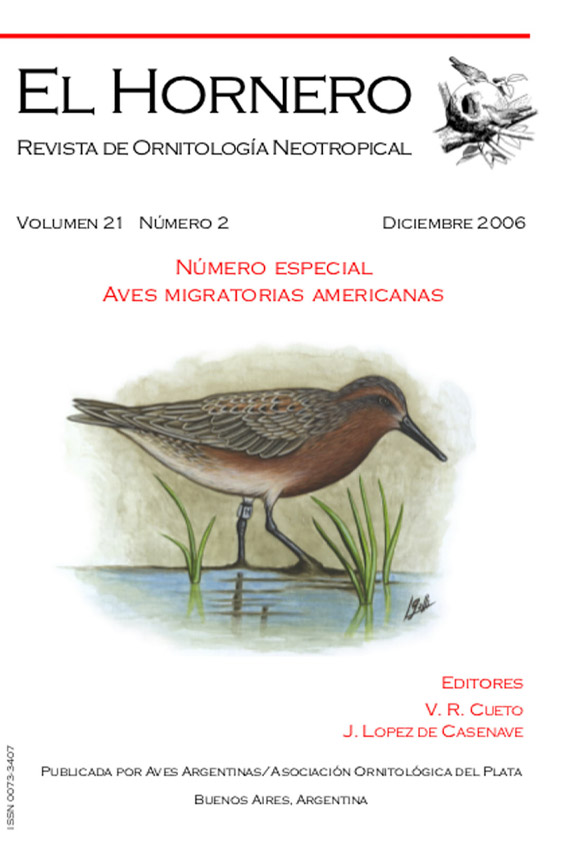Resumen
Se examinó la hipótesis del ayuno durante la migración para el Aguilucho Langostero (Buteo swainsoni) mediante la estimación de la longitud, la duración y la velocidad de migración entre América del Norte y del Sur, y la medición de los cambios en el peso corporal en varios momentos a lo largo del año. Se colocaron transmisores satelitales a 34 aguiluchos adultos en sus áreas de cría en el oeste de América del Norte para determinar la duración, la longitud y la velocidad de la migración. En su migración al sur, a 188 km/día, el Aguilucho Langostero tarda 51 días para completar los 13504 km hasta las áreas donde permanece durante el verano austral. A un promedio de solo 150 km/día en su migración de retorno, le toma 60 días completar los 11952 km de regreso a América del Norte. Los machos y hembras adultos de Aguilucho Langostero tuvieron un peso corporal promedio de 872 g y 1131 g, respectivamente, cuando partían de América del Norte en septiembre, y su peso corporal al arribar a Argentina promedió 759 g en los machos adultos y 933 g en las hembras adultas, indicando que pierden, en promedio, solo el 18% de su peso corporal durante la migración. En febrero, antes de su partida de Argentina, los machos y hembras adultos de Aguilucho Langostero tuvieron un peso corporal de 792 g y 1013 g, respectivamente, y llegaron a sus áreas de cría en América del Norte pesando 802 g y 1087 g, en abril. Los resultados indican que el modelo de ayuno durante la migración no predice los pesos corporales reales del Aguilucho Langostero durante la estación migratoria y que debería ser modificado para dar cuenta de menores gastos energéticos durante la migración o la posibilidad de que las aves usen una estrategia de paradas durante la migración, alimentándose e incorporando (o manteniendo) grasa a lo largo de la ruta migratoria.
Referencias
ALI S AND RIPLEY D (1978) Handbook of birds of Indiaand Pakistan. Oxford University Press, Oxford
BERGER M AND HART JS (1974) Physiology and ener-getics of flight. Pp. 416–477 in: FARNER DS, KING JRAND PARKES KC (eds) Avian biology. Volume 4. Aca-demic Press, New York
BERTHOLD P (1975) Migration: control and metabolicphysiology. Pp. 77–128 in: FARNER DS AND KING JR(eds) Avian biology. Volume 5. Academic Press, New York
BERTHOLD P (1993) Bird migration: a general survey.Oxford University Press, Oxford
BLEM C (1980) The energetics of migration. Pp.175–224 in: GAUTHREAUX SA (ed) Animal migration,orientation, and navigation. Academic Press, New York

Esta obra está bajo una licencia internacional Creative Commons Atribución-NoComercial 4.0.





